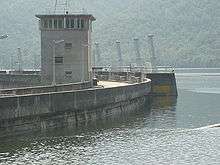Bhumibol Adulyadej
Bhumibol Adulyadej (Thai: ภูมิพลอดุลยเดช; RTGS: Phumiphon Adunyadet; pronounced [pʰūː.mí.pʰōn ʔā.dūn.jā.dèːt] (![]()
| Bhumibol Adulyadej | |
|---|---|
.svg.png) Privy Seal | |
| Thai name | |
| Thai | ภูมิพลอดุลยเดช |
| RTGS | Phumiphon Adunyadet |
Forbes estimated Bhumibol's fortune – including property and investments managed by the Crown Property Bureau, a body that is neither private nor government-owned (assets managed by the Bureau were owned by the crown as an institution, not by the monarch as an individual)[8]– to be US$30 billion in 2010, and he headed the magazine's list of the "world's richest royals" from 2008 to 2013 although the same magazine also estimated the worth of the British monarchy triple that of the Thai.[9][10][11][12] In May 2014, Bhumibol's wealth was again listed as US$30 billion.[13]
After a period of deteriorating health which left him hospitalized on several occasions, Bhumibol died on 13 October 2016 in Siriraj Hospital.[14] He was generally highly revered by the people in Thailand[15][16] – some saw him as close to divine.[17][18] Notable political activists and Thai citizens who criticized the king or the institution of monarchy were often forced into exile or to suffer frequent imprisonments.[19] Yet many cases were dropped before being proceeded or were eventually given royal pardon.[20] His cremation was held on 26 October 2017 at the royal crematorium at Sanam Luang.[21] His son, Maha Vajiralongkorn, succeeded him as King.
Name
.jpg)
.svg.png)
Bhumibol's U.S. birth certificate reads simply "Baby Songkla", as the parents had to consult his uncle, King Rama VII (Prajadhipok), then head of the House of Chakri, for an auspicious name. The king chose a name of Sanskrit origin, Bhumibol Adulyadej (Devanagari: भूमिबल अतुल्यतेज, IAST: Bhūmibala Atulyateja), a compound of Bhūmi (भूमि), meaning "Land"; Bala (बल), meaning "Strength" or "Power"; Atulya (अतुल्य), meaning "Incomparable"; and Tej (तेज), meaning "Power". Thus, Bhūmibala Atulyateja, or Bhumibol Adulyadej as it is transliterated in Thai, can be literally translated as "Strength of the Land, Incomparable Power".
Early life
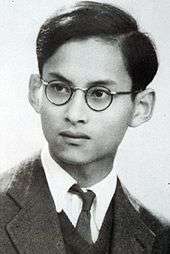
Bhumibol was born at Mount Auburn Hospital in Cambridge, Massachusetts, in the United States, on 5 December 1927.[22] He was the youngest son of Prince Mahidol Adulyadej, the Prince of Songkla, and his commoner wife Mom Sangwan (later Princess Srinagarindra, the Princess Mother). His father was enrolled in the public health program at Harvard University, which is why Bhumibol was the only monarch to be born in the US.[23]:46–47 Bhumibol had an older sister, Princess Galyani Vadhana, and an older brother, Prince Ananda Mahidol.
Bhumibol came to Thailand in 1928, after his father obtained a certificate from Harvard. His father died of kidney failure in September 1929, when Bhumibol was less than two years old.[23]:62 He briefly attended Mater Dei school in Bangkok, but in 1933 his mother took her family to Switzerland, where he continued his education at the École nouvelle de la Suisse romande in Lausanne. In 1934 Bhumibol was given his first camera, which ignited his lifelong enthusiasm for photography.[23]:67 When Bhumibol's childless uncle Prajadhipok abdicated in 1935, his nine-year-old brother Ananda Mahidol became King Rama VIII. However, the family remained in Switzerland and the affairs of the head of state were conducted by a regency council. They returned to Thailand for only two months in 1938. In 1942, Bhumibol became a jazz enthusiast, and started to play the saxophone, a passion that he kept throughout his life.[23]:73–74 He received the baccalauréat des lettres (high-school diploma with a major in French literature, Latin, and Greek) from the Gymnase Classique Cantonal de Lausanne, and by 1945 had begun studying sciences at the University of Lausanne, when World War II ended and the family was able to return to Thailand.[22]
Succession and marriage
Bhumibol ascended the throne following the death by gunshot wound of his brother, King Ananda Mahidol, on 9 June 1946, under circumstances that remain unclear. While a first government statement stated that Ananda had accidentally shot himself,[24]:76–77 an investigation committee ruled this was virtually impossible.[24]:87 Two palace aides were eventually convicted of regicide and executed. A third possibility, that Bhumibol accidentally shot his brother while the brothers played with their pistols, was never officially considered.[24]:77–78[25]
Bhumibol succeeded his brother, but returned to Switzerland before the end of the 100-day mourning period. Despite his interest in science and technology, he changed his major and enrolled in law and political science to prepare for his duties as head of state. His uncle, Rangsit, Prince of Chainat, was appointed Prince Regent. In Bhumibol's name, Prince Rangsit acknowledged a military coup that overthrew the government of Thamrongnawasawat in November 1947.[24]:88 The regent also signed the 1949 constitution, which returned to the monarchy many of the powers it had lost by the 1932 Revolution.[24]:91–93
In December 1946, the Siamese government allocated several hundred thousand dollars for the ceremonial cremation of the remains of the late King Ananda, a necessary preliminary to the coronation of Bhumibol who was required by religious custom to light the funeral pyre. Unsettled conditions in 1947 following a coup d'état resulted in a postponement, and court astrologers determined that 2 March 1949 was the most auspicious date.[26]
While doing his degree in Switzerland, Bhumibol visited Paris frequently. It was in Paris that he first met Mom Rajawongse Sirikit Kitiyakara, daughter of the Thai ambassador to France (Nakkhatra Mangala) and a great-granddaughter of King Chulalongkorn and thus a cousin of Bhumibol. She was then 15 years old and training to be a concert pianist.[26][27]
On 4 October 1948, while Bhumibol was driving a Fiat Topolino on the Geneva-Lausanne road, he collided with the rear of a braking truck 10 km outside Lausanne. He injured his back, suffered paralysis in half of his face and incurred cuts on his face that cost him the sight of his right eye.[24]:104[28] Both the royal cremation and coronation had to be postponed once more.[26] While he was hospitalised in Lausanne, Sirikit visited him frequently. She met his mother, who asked her to continue her studies nearby so that Bhumibol could get to know her better. Bhumibol selected for her a boarding school in Lausanne, Riante Rive.[29] A quiet engagement in Lausanne followed on 19 July 1949, and they were married on 28 April 1950, just a week before his coronation. Their wedding was described by The New York Times as "the shortest, simplest royal wedding ever held in the land of gilded elephants and white umbrellas". The ceremony was performed by Bhumibol's ageing grandmother, Savang Vadhana.[26]
Bhumibol and Sirikit have four children:
- (Formerly HRH) Princess Ubolratana Rajakanya, born 5 April 1951 in Lausanne, Switzerland; married Peter Ladd Jensen (now divorced), and has two daughters. Her son, Bhumi Jensen, was killed in the tsunami caused by the 2004 Indian Ocean earthquake.[30][31]
- King Maha Vajiralongkorn (Rama X), born 28 July 1952; married Mom Luang Soamsawali Kitiyakara (later divorced and became HRH the Princess Niece); one daughter. Then married Yuvadhida Polpraserth (later divorced); four sons and a daughter. Third marriage was to Srirasmi Suwadee (now divorced); one son. Fourth and current marriage is to Suthida Tidjai.
- HRH Princess Maha Chakri Sirindhorn, born 2 April 1955; never married, no issue
- HRH Princess Chulabhorn Walailak, born 4 July 1957; married Virayudh Tishyasarin (now divorced); two daughters
Coronation and titles
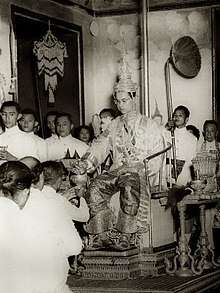
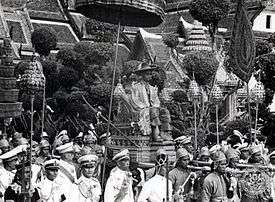
After presiding over the long-delayed, ceremonial cremation of his brother Ananda Mahidol, Bhumibol was crowned King of Thailand on 5 May 1950 in the Baisal Daksin Throne Hall in the Grand Palace in Bangkok. It was the first coronation ceremony of a Thai sovereign to rule under the system of constitutional monarchy.[26] During the ceremony, he pledged that he would "reign with righteousness for the benefit and happiness of the Siamese people" ("เราจะครองแผ่นดินโดยธรรม เพื่อประโยชน์สุขแห่งมหาชนชาวสยาม").[32] Notable elements associated with the coronation included the Bahadrabith Throne beneath the Great White Umbrella of State and royal regalia and utensils.[33]
In 1950 on Coronation Day, Bhumibol's consort was made queen (Somdej Phra Boromarajini). The date of his coronation is celebrated each 5 May in Thailand as Coronation Day, a public holiday. On 9 June 2006, Bhumibol celebrated his 60th anniversary as the King of Thailand, becoming the longest reigning monarch in Thai history.
The royal couple spent their honeymoon at Hua Hin before they returned to Switzerland, where the king completed his university studies. They returned to Thailand in 1951.[26]
Following the death of his grandmother Queen Savang Vadhana, Bhumibol entered a 15-day monkhood (22 October 1956 – 5 November 1956) at Wat Bowonniwet, as is customary for Buddhist males on the death of elder relatives. He was ordained by the Supreme Patriarch on 22 October 1956 at the Royal Chapel of the Emerald Buddha in the Grand Palace.[26][34] During this time, Sirikit was appointed his regent. She was later appointed Queen Regent (Somdej Phra Boromarajininat) in recognition of this.
Although Bhumibol was sometimes referred to as King Rama IX in English, Thais referred to him as Nai Luang or Phra Chao Yu Hua (ในหลวง or พระเจ้าอยู่หัว), which translated to "the King" and "Lord Upon our Heads", respectively. He was also called Chao Chiwit ("Lord of Life").[15] Formally, he was referred to as Phrabat Somdet Phra Chao Yu Hua (พระบาทสมเด็จพระเจ้าอยู่หัว) or, in legal documents, Phrabat Somdet Phra Paraminthara Maha Bhumibol Adulyadej (พระบาทสมเด็จพระปรมินทรมหาภูมิพลอดุลยเดช), and in English as "His Majesty King Bhumibol Adulyadej". He signed his name as ภูมิพลอดุลยเดช ป.ร. (Bhumibol Adulyadej Por Ror, the Thai equivalent of "Bhumibol Adulyadej R[ex])".
Role in Thai politics
_(cropped).jpg)
In 1957, a military coup overthrew the government of Field Marshal Plaek Phibunsongkhram with allegations of lèse-majesté,[24]:136–137[35] corruption and manipulation of the election held earlier that year.[35]:146–148 This began a new and long-lasting relationship between the monarch and military,[36] leading some to perceive that the king condones the Thammasat University massacre in defense of his throne, and support a series of military dictatorships.[24][37] However, during his interview given to the BBC in 1979, the king reiterated that the monarchy should remain impartial and be in peaceful co-existence with everybody.[23]:139–141 Bhumibol invited public criticism in a 2005 speech,[38] but the lèse majesté laws have not been revoked by the Thai parliament yet.
Plaek Phibunsongkhram era
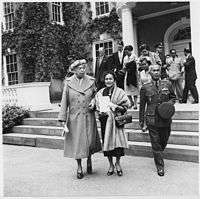
In the early years of his reign, during the government of military dictator Plaek Phibunsongkhram, Bhumibol had no real political power and was little more than a ceremonial figure under the military-dominated government. In August 1957, six months after parliamentary elections, General Sarit Thanarat accused the government of Field Marshal Phibunsongkhram of lèse-majesté due to its conduct of the 2,500th anniversary celebration of Buddhism.[24]:129–130,136–137[35] On 16 September 1957, Phibunsongkhram went to Bhumibol to seek support for his government.[39] Bhumibol advised the field marshal to resign to avoid a coup. Phibunsongkhram refused. That evening, Sarit Thanarat seized power. Two hours later Bhumibol imposed martial law throughout the kingdom.[40] Bhumibol issued a proclamation appointing Sarit as "military defender of the capital" without anyone countersigning the proclamation. It included the following:[41]
Whereas it appears that the public administration by the government under the premiership of Field Marshal P. Phibunsongkhram is untrustworthy, and that the government could not maintain the public order; and whereas the military, led by Field Marshal Sarit Thanarat, has successfully taken over the public administration and now acts as the Military Defender of the Capital; now, therefore, I do hereby appoint Field Marshal Sarit Thanarat as the Military Defender of the Capital, and command that all the citizens shall remain calm whilst all the government officers shall serve the orders issued by Field Marshal Sarit Thanarat. This Proclamation shall come into force immediately. Done this 16th Day of September, Buddhist Era 2500 (1957).
Sarit later admitted in a rare interview with foreign correspondent that the king had no involvement and did not acknowledge anything about the coup until it had been done successfully.[42]
Sarit Thanarat era
.jpg)
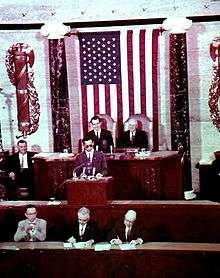
During Sarit's dictatorship, the monarchy was revitalised. Bhumibol attended public ceremonies, toured the provinces and patronised development projects, he also visited the United States and many countries in Europe. Under Sarit, the practice of crawling in front of royalty during audiences, banned by King Chulalongkorn, was revived in certain situations and the royal-sponsored Thammayut Nikaya order was revitalised. For the first time since the absolute monarchy was overthrown, a king was conveyed up the Chao Phraya River in a Royal Barge Procession to offer robes at temples.[43][44]
Other disused ceremonies from the classical period of the Chakri Dynasty, such as the royally patronised ploughing ceremony (Thai: พิธีพืชมงคล), were also revived.[45] Bhumibol's birthday (5 December) was declared the national day, replacing the previous national day, the anniversary of the Siamese revolution of 1932 (24 June).[46] Upon Sarit's death on 8 December 1963, an unprecedented 21 days of mourning were declared in the palace. A royal five-tier umbrella shaded his body while it lay in state. Long-time royal adviser Phraya Srivisaravacha later noted that no Prime Minister ever had such an intimate relationship with Bhumibol as Sarit.[47]
Bhumibol biographer Paul Handley, in The King Never Smiles, writes that the dictator Sarit was Bhumibol's tool. Political scientist Thak Chaloemtiarana writes that Sarit used Bhumibol in order to build his own credibility.[48][49]
Thammasat University massacre
Following Sarit's death General Thanom Kittikachorn rose to power to lead Thailand's military dictatorship, ultimately challenged by the 1973 Thai popular uprising. Bhumibol initially asked student protestors to disband. When police attacked and killed dozens of students, sparking protest riots, Bhumibol announced general Thanom's resignation and departure from Thailand.[50] According to William Stevenson, the king had asked the three tyrants to avoid bloodshed, although the three tyrants had agreed, they later changed their minds. Eventually, it led to the incidents of October 1973.[51]
Bhumibol distanced himself from the Thai military after Thanom's fall. Political events in Vietnam, Cambodia and Laos brought powerful guerrilla and communist movements into power or prominence, which threatened the Thai monarchy and political establishment. Fearing unrest, Bhumibol began to court the military in 1975, visiting camps throughout the country, and publicly warning of internal and external threats.[37]:87 At this time, Bhumibol increasingly cultivated far-right militias and paramilitary forces, including the Red Gaurs and the Village Scouts, warning that students and political dissidents planned to bring communists to power in Thailand.[24]:232–9 Finally, Bhumibol provoked outrage among students and legal groups by inviting general Thanom back into the country.
The ensuing chaos was used as a pretext for a military coup, which Bhumibol backed and described as a manifestation of the people's will.[37]:90–1 The event that catalyzed the coup was the Thammasat University massacre, carried out in the name of defending Bhumibol's throne.[24]:9 The victorious military junta submitted three names to the king as possible premiers: Deputy President of the king's Privy Council Prakob Hutasingh, right-wing Bangkok Governor Thamnoon Thien-ngern, and staunchly anti-communist Supreme Court judge Thanin Kraivichien.[37]:90–1[52] Thanin was a member of the Nawaphon monarchist paramilitary group, which had the backing of the CIA, and which Bhumibol was alleged to have sponsored.[37]:84–5 Bhumibol chose Thanin as the most suitable premier, leading student protesters to flee to join the communists in the jungle. Thanin was overthrown in a military coup in October 1977 led by General Kriangsak Chamanan.
Prem Tinsulanonda era
Kriangsak was succeeded in 1980 by the popular Army Commander-in-Chief, General Prem Tinsulanonda, who later became the Privy Council President.
Bhumibol's refusal to endorse military coups in 1981 (the April Fool's Day coup) and 1985 (the Share Rebellion) ultimately led to the victory of forces loyal to the government, despite some violence – including, in 1981, the seizure of Bangkok by rebel forces. The coups led many to believe that Bhumibol had misjudged Thai society and that his credibility as an impartial mediator between various political and military factions had been compromised.[53][54][55]
Following the death of Emperor Hirohito of Japan in 1989, he overtook the distinction as the world's longest-reigning living monarch.[56]
Crisis of 1992
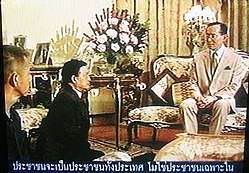
In 1992, Bhumibol played a key role in Thailand's transition to a democratic system. A coup on 23 February 1991 returned Thailand to military dictatorship. After a general election in 1992, the majority parties invited General Suchinda Kraprayoon, a leader of the coup group, to be prime minister. This caused much dissent, which escalated into demonstrations that led to a large number of deaths when the military was brought in to control protesters. The situation became increasingly critical as police and military forces clashed with protesters. Violence and riots spread to many areas of the capital with rumours of a rift among the armed forces.[57]
Amidst the fear of civil war, Bhumibol intervened. He summoned Suchinda and the leader of the pro-democracy movement, retired Major General Chamlong Srimuang, to a televised audience, and urged them to find a peaceful resolution. At the height of the crisis, the sight of both men appearing together on their knees (in accordance with royal protocol) made a strong impression on the nation, and led to Suchinda's resignation soon afterwards.
It was one of the few occasions in which Bhumibol directly and publicly intervened in a political conflict. A general election was held shortly afterward, leading to a civilian government.[58]
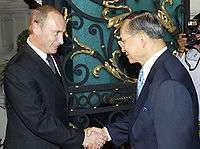
2003 War on Drugs
In his 4 December 2002 speech on the eve of his birthday, King Bhumibol spoke about the rise in drug use, the high social costs and deaths caused by drugs.[59] Privy Councillor General Phichit Kunlawanit called on the Thaksin Shinawatra government to use its majority in parliament to establish a special court to deal with drug dealers, stating that "if we execute 60,000 the land will rise and our descendants will escape bad karma".[60]
On 14 January 2003, Thaksin launched a campaign to rid "every square inch of the country" of drugs.[61] His "war on drugs" campaign consisted of setting provincial arrest and seizure quotas including "blacklists", awarding government officials for achieving targets, and threatening punishment for those who failed to make the quota, targeted dealers, and propagated a ruthless carrying out of the campaign. In the first three months, Human Rights Watch reported that 2,275 people were killed, almost double the number normally killed in drug-related violence.[62] Human rights critics claimed a large number were extrajudicially executed.[63][64] The War on Drugs was widely criticized by the international community.[65]
According to the Narcotics Control Board, the campaign was effective in reducing drug consumption, especially in schools.[66] Bhumibol, in a 2003 birthday speech, warned Thaksin and criticized those who counted only dead drug dealers while ignoring deaths caused by drugs.[67]
"Victory in the War on Drugs is good. They may blame the crackdown for more than 2,500 deaths, but this is a small price to pay. If the prime minister failed to curb [the drug trade], over the years the number of deaths would easily surpass this toll."[68]
After the 2006 coup, the military junta appointed a committee led by former Attorney General Kanit Na Nakorn to investigate deaths in the war on drugs.[69] The committee found that over half of those killed in 2003 had no links to the drug trade and blamed the violence on a government "shoot-to-kill" policy based on flawed blacklists. However, no one has been prosecuted, with interim Prime Minister Surayud Chulanont stating that there was insufficient evidence to take legal action.[70]
While he was opposition leader, Abhisit Vejjajiva accused Thaksin of crimes against humanity in the war on drugs. After he became Prime Minister, Abhisit opened an investigation led by former attorney-general Kampee Kaewcharoen, claiming that a successful probe could lead to prosecution by the International Criminal Court.[62][71]
Crisis of 2005–2006 and the September 2006 coup
Background to the coup
Weeks before the April 2006 legislative election, the Democrat Party-led opposition and the People's Alliance for Democracy petitioned Bhumibol to appoint a replacement prime minister and cabinet. Demands for royal intervention were met with much criticism from the public. Bhumibol, in a speech on 26 April 2006, responded, "Asking for a Royally-appointed prime minister is undemocratic. It is, pardon me, a mess. It is irrational".[72]
After publicly claiming victory in the boycotted April parliamentary elections, Thaksin Shinawatra had a private audience with the king. A few hours later, Thaksin appeared on national television to announce that he would be taking a break from politics.
In May 2006, the Sondhi Limthongkul-owned Manager Daily newspaper published a series of articles describing the "Finland Plot", alleging that Thaksin and former members of the Communist Party of Thailand planned to overthrow the king and seize control of the nation. No evidence was ever produced to verify the existence of such a plot, and Thaksin and his Thai Rak Thai party vehemently denied the accusations and sued the accusers.
In a rare, televised speech to senior judges, Bhumibol requested the judiciary to take action to resolve the political crisis.[72] On 8 May 2006, the Constitutional Court invalidated the results of the April elections and ordered new elections scheduled for 15 October 2006.[73] The Criminal Court later jailed the Election Commissioners.[74][75]
On 14 July 2006, Privy Council President Prem Tinsulanonda addressed graduating cadets of the Chulachomklao Royal Military Academy, telling them that the Thai military must serve the nation and the king—not the government.[76]
On 20 July, Bhumibol signed a royal decree endorsing new House elections for 15 October 2006. In an unprecedented act, the King wrote a note on the royal decree calling for a clean and fair election. That very day, Bhumibol underwent spinal surgery.[77]
The coup
On the evening of 19 September, the Thai military overthrew the Thaksin government and seized control of Bangkok in a bloodless coup. The junta, led by the Sonthi Boonyaratglin, Commander of the Army, called itself the Council for Democratic Reform under the Constitutional Monarchy. It accused the deposed prime minister and his regime of crimes, including lèse majesté, and pledged its loyalty to Bhumibol. Martial law was declared, the constitution repealed and the October elections cancelled. Protests and political meetings were banned.[78]
The king's role in the coup was the subject of much speculation among Thai analysts and the international media, although publication of such speculation was banned in Thailand. The king had an audience with Privy Council President Prem Tinsulanonda at the same time that special forces troops were mobilised.[79] Anti-coup protesters claimed that Prem was the mastermind of the coup, although the military claimed otherwise and banned any discussion of the topic. In a BBC interview, Thitinan Pongsudhirak of Chulalongkorn University noted, "This coup was nothing short of Thaksin versus the King... He [the king] is widely seen as having implicitly endorsed the coup." In the same interview, social critic Sulak Sivaraksa claimed, "Without his [the king's] involvement, the coup would have been impossible." Sulak added that the king is "very skillful. He never becomes obviously involved. If this coup goes wrong, Sonthi will get the blame, but whatever happens, the King will only get praise."[80] On Saturday, 23 September 2006, the junta warned it would "urgently retaliate against foreign reporters whose coverage has been deemed insulting to the monarchy."[81] Prem did help secure the appointment of Surayud Chulanont, another member of the King's Privy Council, as Premier, and allegedly had a say in the appointment of Surayud's Cabinet. Critics claimed the cabinet was full of "Prem's boys".[82][83][84]
On 20 April 2009, Thaksin claimed in an interview with the Financial Times that Bhumibol had been briefed by Privy Councillors Prem Tinsulanonda and Surayud Chulanont about their plans to stage the 2006 coup. He claimed that General Panlop Pinmanee, a leader of the People's Alliance for Democracy, had told him of the briefing.[85][86] The Thai embassy in London denied Thaksin's claims.
After the coup
The junta appointed a constitutional tribunal to rule on alleged polling fraud involving the Thai Rak Thai and Democrat political parties. Guilty rulings would have dissolved both parties, Thailand's largest and oldest, respectively, and banned the parties' leadership from politics for five years. The weeks leading up to the verdicts saw rising political tensions. On 24 May 2007, about a week before the scheduled verdict, Bhumibol gave a rare speech to the Supreme Administrative Court (the president of which is also a member of the constitutional tribunal). "You have the responsibility to prevent the country from collapsing", he warned them in the speech, which was shown on all national television channels simultaneously during the evening. "The nation needs political parties... In my mind, I have a judgment but I cannot say", he said. "Either way the ruling goes, it will be bad for the country, there will be mistakes".[87][88][89] The tribunal later acquitted the Democrat Party, but dissolved the Thai Rak Thai Party and banned 111 of its executives from politics for five years.
The junta-appointed Constitution Drafting Assembly later tried to use the King in a propaganda campaign to increase public support for its widely criticised draft constitution. The CDA placed billboards saying "Love the King. Care about the King. Vote in the referendum" throughout northeast Thailand, where opposition to the junta was greatest.[90]
2008 crisis
The military's constitution passed the referendum, and a general election was held in December 2007. The People's Power Party (PPP), consisting of many former Thai Rak Thai Party MPs and supporters, won the majority and formed a government.[91] The People's Alliance for Democracy (PAD) refused to accept the election results and started protests, eventually laying siege to Government House, Don Mueang Airport, and Suvarnabhumi Airport. Although the PAD claimed they were defending the monarchy, Bhumibol remained silent. However, after a PAD supporter died in a clash with police, Queen Sirikit presided over her cremation. Princess Sirindhorn, when asked at a U.S. press conference whether PAD was acting on behalf of the monarchy, replied, "I don't think so. They do things for themselves."[92] Questioning and criticism over Bhumibol's role in the crisis increased, particularly from the international press.[93][94][95][96][97][98][99] "It is more and more difficult for them to hold the illusion that the monarchy is universally adored", says a Thai academic.[100]
In April 2008, Bhumibol appointed alleged coup plotter General Surayud Chulanont to the Privy Council of Thailand. In the weeks leading up to the 2011 general election, Bhumibol appointed Air Chief Marshal Chalit Pukbhasuk, a leader of the 2006 military coup, to his privy council.[101]
Declining health
Bhumibol suffered from lumbar spinal stenosis, and received a microsurgical decompression for the condition in July 2006.[102][103] He was admitted to the hospital in October 2007 and diagnosed with a blood shortage to his brain.[104] He received treatment for various ailments including heart problems and was released after three weeks.[105]
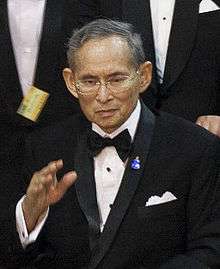
Bhumibol was again admitted to Siriraj Hospital in September 2009, apparently suffering from flu and pneumonia. In 2011, it was revealed as part of WikiLeaks's leak of United States diplomatic cables that he had suffered from Parkinson's disease and depression.[106] He was diagnosed with diverticulitis in hospital in November 2011, and was treated for the condition in January 2012.[107] Bhumibol suffered minute subdural bleeding in the left frontal area of his brain for which he was treated in July 2012.[108] Bhumibol left the hospital in July 2013,[109] and travelled to Klai Kangwon Palace at Hua Hin on 2 August 2013,[110] but returned intermittently in the following years, most recently on 1 June 2015.[111] Bhumibol was too ill to appear for the public celebration of his birthday on 5 December 2015,[112] but made a televised appearance on 14 December, his first in several months.[113] The King temporarily left hospital to visit Chitralada Royal Villa on 11 January 2016 but returned later that day.[114]
On 1 October 2016, the palace released a bulletin stating that after recovering from a fever, King Bhumibol underwent tests that revealed a blood infection and an X-ray found inflammation on his left lung, along with water in his lungs.[115] He had been in kidney failure for some time and received dialysis.[116][117] By 9 October, he had been placed on a ventilator and doctors pronounced him "not yet stable".[118] Crowds of well-wishers, many dressed in pink symbolizing good health and luck, gathered outside Siriraj Hospital and the Grand Palace to offer prayers and support.[119]
By 12 October, the royal children had arrived at Siriraj Hospital and Crown Prince Vajiralongkorn had met with the prime minister.[120][121] There were some internal concerns about the succession of the crown prince, in that he was not perceived to be as well-respected as his father and it was speculated that some palace elites, responding to the people's admiration for Princess Maha Chakri Sirindhorn, might try to position her to take the throne.[122][123]
Death
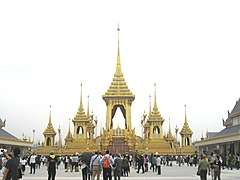
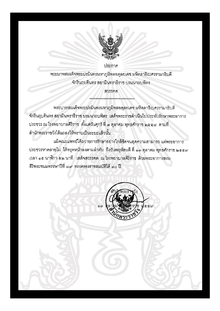
King Bhumibol Adulyadej died in Siriraj Hospital in Bangkok, Thailand on 13 October 2016, at 15:52 local time, at the age of 88, as announced by the royal palace later that day.[5] The following day, his body was taken by motorcade to the Grand Palace for the customary bathing rite.[124] Thousands of the bereaved public lined the route, demonstrating their affection for their "king of kings". The royal procession arrived at the Grand Palace through Viset Chaisri Gate at 17:00. His only son and the next in line to rule the kingdom, Crown Prince Maha Vajiralongkorn, presided over the bathing ritual at Phiman Rattaya Throne Hall.[125]
A royal cremation ceremony took place over five days at the end of October 2017. The actual cremation, which was not broadcast on television, was held in the late evening of 26 October 2017.[126][127] Following cremation his ashes were taken to the Grand Palace and were enshrined at the Chakri Maha Phasat Throne Hall (royal remains), the Royal Cemetery at Wat Ratchabophit and the Wat Bowonniwet Vihara Royal Temple (royal ashes).[128] Following burial, the mourning period officially ended on midnight of 30 October 2017 and Thais have resumed wearing regular colours, while awaiting the future coronation of King Vajiralongkorn, which was hosted between 4–6 May 2019.[129]
Royal powers
Constitutional powers
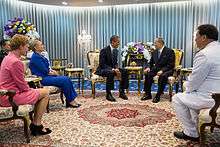
Bhumibol retained enormous powers, partly because of his immense popularity and partly because his powers – although clearly defined in the Thai constitution – were often subject to conflicting interpretations. This was highlighted by the controversy surrounding the appointment of Jaruvan Maintaka as Auditor-General. Jaruvan had been appointed by The State Audit Commission, but in July 2004, the Constitutional Court ruled that her appointment was unconstitutional. Jaruvan refused to vacate her office without an explicit order from Bhumibol, on the grounds that she had previously been royally approved. When the Senate elected a replacement for Jaruvan, Bhumibol refused to approve him.[130] The Senate declined to vote to override Bhumibol's veto.[131] Finally in February 2006 the Audit Commission reinstated Jaruvan when it became clear from a memo from the Office of the King's Principal Private Secretary that King Bhumibol supported her appointment. Bhumibol only vetoed legislation on rare occasions. In 1976, when the Parliament voted 149–19 to extend democratic elections down to district levels, Bhumibol refused to sign the law.[24]:233 The Parliament refused to vote to overturn the King's veto. In 1954, Bhumibol vetoed parliamentary-approved land reform legislation twice before consenting to sign it.[24]:126 The law limited the maximum land an individual could hold to 50 rai (80,000 square metres (860,000 sq ft)), at a time when the Crown Property Bureau was the kingdom's largest land-owner. The law was not enforced as General Sarit soon overthrew the elected government in a coup and repealed the law.
Bhumibol had the constitutional prerogative to pardon criminals, although there are several criteria for receiving a pardon, including age and remaining sentence. The 2006 pardoning of several convicted child rapists, including an Australian rapist and child pornographer, caused controversy.[132][133][134] However, under the Thai constitution, the king has the prerogative to grant pardons and all laws, royal rescripts, and royal commands relating to state affairs must be countersigned by a minister unless otherwise provided for in the constitution.
Network monarchy and extraconstitutional powers
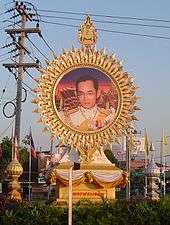
Several academics outside Thailand, including Duncan McCargo and Federico Ferrara, noted the active but indirect political involvement of Bhumibol through a "network monarchy", whose most significant proxy is Privy Council President Prem Tinsulanonda. McCargo claimed that Bhumibol's conservative network worked behind the scenes to establish political influence in the 1990s, but was threatened by the landslide election victories of Thaksin Shinawatra in 2001 and 2005.[135] Ferrara claimed, shortly before the Thai Supreme Court delivered its verdict to seize Thaksin Shinawatra's assets, that the judiciary was a well-established part of Bhumibol's network and represented his main avenue to exercise extra-constitutional prerogatives despite having the appearance of being constitutional. He also noted how, in comparison to the Constitutional Court's 2001 acquittal of Thaksin, the judiciary was a much more important part of the "network" than it was in the past.[136]
The network's ability to exercise power is based partly on Bhumibol's popularity and strict control of Bhumibol's popular image. According to Jost Pachaly of the Heinrich Böll Foundation, Bhumibol "plays an important role behind the scenes. But the role is difficult to assess because nothing is reported about it and no one really knows anything specific", due to lese majeste laws forbidding discussion about Bhumibol's political activities.[137] Bhumibol's popularity was demonstrated following the 2003 Phnom Penh riots in Cambodia, when hundreds of Thai protesters, enraged by rumors that Cambodian rioters had stomped on photographs of Bhumibol, gathered outside the Cambodian embassy in Bangkok. Photographs of the stomping were not published in Thailand, but were available on the internet. The situation was resolved peacefully only when Police General Sant Sarutanonda told the crowd that he had received a call from royal secretary Arsa Sarasin conveying Bhumibol's request for calm. The crowd dispersed.[138]
Royal projects
History
The development of the country must be fostered in stages. It must start with the construction of infrastructure, that is, the provision of food and basic necessities for the people by methods which are economic, cautious and conforming with principles. Once the foundation is firmly established, progress can be continually, carefully and economically promoted. This approach will prevent incurring mistakes and failures, and lead to the certain and complete achievement of the objectives.
Bhumibol was involved in many social and economic development projects. The nature of his involvement varied by political regime.[140]
The government of Plaek Phibunsongkhram (1951–1957) limited Bhumibol to a ceremonial role. During that period Bhumibol produced some films and operated a radio station from Chitlada Palace using personal funds.
In the military governments of Sarit Thanarat and his successors (1958–1980), Bhumibol was portrayed as the "development King" and the inspiration for the economic and political goals of the regime. Royally ordered projects were implemented under the financial and political support of the government, including projects in rural areas and communities under the influence of the Communist Party of Thailand. Bhumibol's visits to these projects were heavily promoted by the Sarit government and broadcast in state-controlled media.
During the governments of General Prem Tinsulanonda (1981–1987), the relationship between the Thai state and the monarch was at its closest. Prem, later to become President of Bhumibol's Privy Council, officially allocated government budgets and manpower to support royal projects. Most activities in this period involved the development of large-scale irrigation projects in rural areas.
During the modern period (post-1988), the structured development of the royal projects reached its apex. Bhumibol's Chaipattana Foundation was established, promoting his "sufficiency economy" theory, an alternative to the export-oriented policies adopted by the period's elected governments. Following the 2006 coup, establishment of a "sufficiency economy" was enshrined in the constitution as being a primary goal of the government, and government financial support for royal projects was boosted.
Project samplings
.jpg)
- 'Sandwich' and 'Supersandwich' artificial rainmaking project under the Thailand Royal Rainmaking Project
- Chai Pattana Waste Water Aerator, awarded gold medal by BKU (The Belgian Chamber of Inventors) at Brussels Eureka 2000
- 'Sufficiency Economy' Theory
- New Theory of Agriculture
- Use of Vetivar Grass for Soil Improvement, awarded the International Merit Award by the IECA (International Erosion Control Association)
- Kaem Ling Project, formation of detention basins[141]
- Klaeng Din Project, acidic soil treatment[142]
- Fai Maeo Project, formation of check dams
- Khun Dan Prakanchon Dam, Nakhon Nayok Province
- Pa Sak Jolasid Dam, Lop Buri Province
- Pa Sak River Basin Improvement Project
- Khlong Lat Pho Project, water diversion to prevent flooding in Bangkok
- Rama VIII Bridge
- Ratchadaphisek Road
- Bangkok Industrial Ring Road/Bhumibol Bridge
- Huai Ongkod Land Rehabilitation Project, Kanchanaburi Province
- Khao Hin Son Royal Development Study Centre, Chachoengsao Province
- Phikun Thong Royal Development Study Centre, Narathiwat Province
- Huai Sai Royal Development Study Centre, Phetchaburi Province
- Royal Medical Team. Bhumibol's private physicians accompanying him on village tours were encouraged to provide medical care for local residents. In addition, the Royal Household sends letters of support to physicians who volunteer to serve in hospitals in provinces where royal palaces are present.[143]
- In honour of his work in soil science, the United Nations observes the king's birthday, 5 December, as World Soil Day. The first observance was in 2014.[144][145]
60th anniversary celebrations
.jpg)
Also called the Diamond Jubilee, the 60th anniversary celebrations of the king's accession to the throne were a series of events marking Bhumibol's reign in June 2006. Events included a royal barge procession on the Chao Phraya River, fireworks displays, art exhibitions, and the pardoning of 25,000 prisoners,[146] concerts, and dance performances.
Tied in with the anniversary, United Nations Secretary-General Kofi Annan presented Bhumibol with the United Nations Development Programme's first Human Development Lifetime Achievement Award on 26 May 2006. National holidays were observed on 9 June and 12–13 June 2006. On 9 June, the king and queen appeared on the balcony of Ananta Samakhom Throne Hall before hundreds of thousands of people. The official royal barge procession on 12 June was attended by the king and queen and royal visitors from 26 other countries. On 13 June, a state banquet for the royal visitors was held in the newly constructed Rama IX Throne Hall at the Grand Palace, the first official function of the hall. The Chiang Mai Royal Floral Expo was also held to honour the anniversary.
On 16 January 2007, the CDRM officially declared the end of the 60th anniversary celebrations and commenced year-long celebrations of Bhumibol's 80th birthday.[147]
Private life
| Monarchs of the Chakri dynasty | |
|---|---|
| Phra Buddha Yodfa Chulaloke (Rama I) | |
| Phra Buddha Loetla Nabhalai (Rama II) | |
| Nangklao (Rama III) | |
| Mongkut (Rama IV) | |
| Chulalongkorn (Rama V) | |
| Vajiravudh (Rama VI) | |
| Prajadhipok (Rama VII) | |
| Ananda Mahidol (Rama VIII) | |
| Bhumibol Adulyadej (Rama IX) | |
| Vajiralongkorn (Rama X) | |
Bhumibol was a painter, musician, photographer, author and translator. His book Phra Mahachanok is based on a traditional Jataka story of Buddhist scripture. The Story of Thong Daeng is the story of his dog Thong Daeng.[148]
In his youth, Bhumibol was greatly interested in firearms. He kept a carbine, a Sten gun and two automatic pistols in his bedroom, and he and his elder brother, King Ananda Mahidol, often used the gardens of the palace for target practice.[24]:70
There are two English-language books that provide extensive detail—albeit not always verifiable—about Bhumibol's life, especially his early years and then throughout his entire reign. One is The Revolutionary King (2001) by William Stevenson, the other is The King Never Smiles (2006) by Paul M. Handley. A third and earlier work, The Devil's Discus (1964), is also available in Thai and English. The latter two books are banned in Thailand, while the first has never been sold in the country due to its "inaccuracies", despite having been written with royal patronage.[24]:162
Bhumibol's creativity in, among other things, music, art and invention, was the focus of a two-minute long documentary created by the government of Abhibisit Vejjajiva that was screened at all branches of the Major Cineplex Group and SF Cinema City, the two largest cinema chains in Thailand.[149]
Music
.jpg)
Bhumibol was an accomplished jazz saxophone player and composer, playing Dixieland and New Orleans jazz, and also the clarinet, trumpet, guitar, and piano.[150] It is widely believed that his father, Mahidol Adulyadej, may have inspired his passion for artistic pursuits at an early age.[151] Bhumibol initially focused on classical music exclusively for two years but eventually switched to jazz since it allowed him to improvise more freely. It was during this time that he decided to specialize in wind instruments, especially the saxophone and clarinet.[151] By the time Bhumibol turned 18, he started to compose his own music with the first being Candlelight Blues.[151] He continued to compose even during his reign following his coronation in 1946. Bhumibol performed with Preservation Hall Jazz Band, Benny Goodman, Stan Getz, Lionel Hampton, and Benny Carter.[150][152] Throughout his life, Bhumibol wrote a total of 49 compositions. Much of it is jazz swing but he also composed marches, waltzes, and Thai patriotic songs. His most popular compositions were Candlelight Blues, Love at Sundown, and Falling Rain which were all composed in 1946.[150] Bhumibol's musical influences included Louis Armstrong, Sidney Bechet, Benny Carter, and Johnny Hodges.[150] The Bhumibol Adulyadej (King of Thailand) Collection, 1946-1954 at the Library of Congress Music Division includes some of his compositions, including 13 music manuscripts, 100 pieces of printed music, clippings, correspondence, and other miscellaneous documents.[153]
Bhumibol initially received general music training privately while he was studying in Switzerland, but his older brother, then King Ananda Mahidol, who had bought a saxophone, sent Bhumibol in his place.[152] King Ananda would later join him on the clarinet.[152] On his permanent return to Thailand in 1950, Bhumibol started a jazz band, Lay Kram, whom he performed with on a radio station he started at his palace.[152] The band grew, being renamed the Au Sau Wan Suk Band and he would perform with them live on Friday evenings, occasionally taking telephoned requests.[152] Bhumibol also performed with his band at Thai universities, composing anthems for the universities of Chulalongkorn, Thammasat, and Kasetsart.[152] Bhumibol performed with Benny Goodman at the Amphorn Sathan Residential Hall, in 1956, and later played at Goodman's home in New York in 1960.[150] Many bands such as Les Brown and His Band of Renown, Claude Bolling Big Band, and Preservation Hall Jazz Band recorded some of Bhumibol's compositions and can still be heard in Thailand.[150] A 1996 documentary, Gitarajan, was made about Bhumibol's music.[150]
Bhumibol still played music with his Au Sau Wan Suk Band in later years, but was rarely heard in public.[152] In 1964, Bhumibol became the 23rd person to receive the Certificate of Bestowal of Honorary Membership on behalf of Vienna's University of Music and Performing Arts.[151] In 2000, he was awarded the Sanford Medal for his contribution in music from Yale School of Music. He was the first Asian in both cases to be honored as such. In 2003, the University of North Texas College of Music awarded him an honorary doctorate in music. Bhumibol's influence is widely regarded as one reason why Thailand, and Bangkok in particular, has for decades had a strong jazz and improvised music "scene" relative to other Asian nations.
Sailing
Bhumibol was an accomplished sailor and sailboat designer.[154] He won a gold medal for sailing in the Fourth Southeast Asian Peninsular (SEAP) Games in 1967, together with Princess Ubol Ratana whom he tied for points.[155] This accomplishment was all the more remarkable given Bhumibol's lack of binocular depth perception. On 19 April 1966, Bhumibol also sailed the Gulf of Thailand from Hua Hin to Toey Ngam Harbour[156] in Sattahip, covering 60 nautical miles (110 km) in a 17-hour journey on the "Vega 1", an OK Class dinghy he built.[24]
Like his father, a former military naval engineer, Bhumibol was an avid boat designer and builder. He produced several small sailboat designs in the International Enterprise, OK, and Moth classes. His designs in the Moth class included the "Mod", "Super Mod", and "Micro Mod".[157]
Radio amateur
Bhumibol was a radio amateur with the call sign HS1A. He was also the patron of the Radio Amateur Society of Thailand (RAST).[158]
Wealth
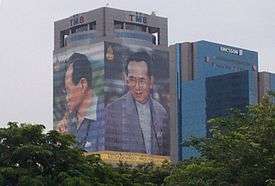
Estimates of the post-devaluation (c. 1997–1998) wealth of the royal household and the Crown Property Bureau (CPB) range from US$10–20 billion.[164] In August 2008, Forbes published its 2008 version of The World's Richest Royals and King Bhumibol was listed first, with an estimated wealth of US$35 billion.[165] A few days later, the Ministry of Foreign Affairs of Thailand issued a statement that the Forbes report incorrectly conflated the wealth of the CPB and that of Bhumibol.[166] In the 2009 Forbes list, the Thai government's objections were acknowledged, but Forbes justified the continued inclusion of the CPB's assets, as the bureau is responsible for handling the Crown's property and investments.[10] The 2009 estimate was a reduced figure of US$30 billion due to declines in real estate and stocks, and this figure was also published in April 2014 by Business Spectator, which also confirmed that the CPB is the body responsible for the management of the Crown's wealth.[10][13]
The wealth and properties of Bhumibol and the royal family are managed by the Privy Purse. The CPB manages the assets of the Crown as an institution. It was established by law, but is directed without the involvement of the Thai government and reports only to the king.[167] The CPB receives many state privileges. Although the minister of finance presides over the CPB's board of directors, final decisions were made solely by Bhumibol. During his lifetime Bhumibol was the only person who could view the CPB's annual report, which was not released to the public.[168]
Through the CPB, the Crown owns equity in many companies and massive amounts of land, including 3,320 acres in central Bangkok, as well as 13,200 acres of rural land.[13][169] The CPB owns 32 percent of Siam Cement (worth US$12.6 billion), 23 percent of Siam Commercial Bank (Thailand's largest bank), and interests in Christiani & Nielsen, Deves Insurance, and Shin Corporation.[13]
The CPB also lets or leases about 36,000 properties to third parties, including the sites of the Anantara Siam Bangkok Hotel, the Suan Lum Night Bazaar, Siam Paragon, and the Central World Tower. The CPB spearheaded a plan to turn Bangkok's historical Ratchadamnoen Avenue into a shopping street known as the "Champs-Élysées of Asia" and in 2007, shocked longtime residents of traditional marketplace districts by serving them with eviction notices.[168] The Crown's substantial income from the CPB, estimated to be at least five billion baht in 2004, is exempt from taxes.[168][170]
King Bhumibol was the owner of the Golden Jubilee Diamond, the largest faceted diamond in the world, which is estimated to be worth between US$4–12 million in April 2014.[13]
Criticism
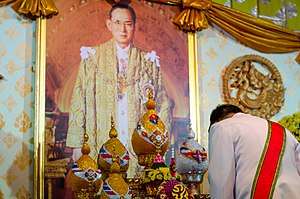
Although Bhumibol was held in great respect by many Thais,[15] he was also protected by lèse-majesté laws which allowed critics to be jailed for three to fifteen years.[171] After the Thammasat University Massacre in 1976, the laws were toughened during the dictatorship of royalist and anti-communist Premier Thanin Kraivichien. Criticism of any member of the royal family, the royal development projects, the royal institution, the Chakri Dynasty or any previous Thai king was also banned.
During his 2005 birthday speech, Bhumibol invited criticism: "Actually, I must also be criticised. I am not afraid if the criticism concerns what I do wrong, because then I know. Because if you say the king cannot be criticised, it means that the king is not human", he claimed. "If the king can do no wrong, it is akin to looking down upon him because the king is not being treated as a human being. But the king can do wrong."[38] A widespread barrage of criticisms resulted, followed by a sharp rise in lèse-majesté prosecutions. Lèse-majesté cases rose from five or six a year pre-2005 to 478 in 2010.[172]
Although lèse-majesté officially only applies to current kings, the law is very flexible in practice. Even after his death, Bhumibol remains protected by lèse-majesté.
Biographies
American journalist Paul Handley, who spent thirteen years in Thailand, wrote the biography The King Never Smiles. The Information and Communications Ministry banned the book and blocked the book's page on the Yale University Press website in January 2006. In a statement dated 19 January 2006, Thai National Police Chief General Kowit Wattana said the book had "contents which could affect national security and the good morality of the people".[173] The book provided a detailed discussion of Bhumibol's role in Thai political history, and it also analyzed the factors behind Bhumibol's popularity.
William Stevenson, who had access to the royal court and the royal family, wrote the biography The Revolutionary King in 2001.[174] An article in Time said the idea for the book was suggested by Bhumibol.[175] Critics noted that the book displayed intimate knowledge about personal aspects of Bhumibol. However, the book was unofficially banned in Thailand and the Bureau of the Royal Household warned the Thai media about even referring to it in print. An official ban was not possible as it was written with Bhumibol's blessing. The book was criticised for factual inaccuracies, disrespecting Bhumibol (it refers to him by his personal nickname "Lek"), and proposing a controversial theory explaining the mysterious death of King Ananda. Stevenson said: "The king said from the beginning the book would be dangerous for him and for me."[175]
Succession to the throne
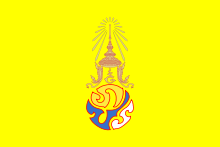
Bhumibol's only son, Prince Vajiralongkorn, was given the title "Somdej Phra Boroma Orasadhiraj Chao Fah Maha Vajiralongkorn Sayam Makutrajakuman" (Crown Prince of Siam) on 28 December 1972 and made heir apparent (องค์รัชทายาท) to the throne in accordance with the Palace Law on Succession of 1924.[176]
On 5 December 1977, Princess Sirindhorn was given the title "Siam Boromrajakumari" (Princess Royal of Siam). Her title is often translated by the English-language press as "Crown Princess", although her official English-language title is simply "Princess".[177]
Although the constitution was later amended to allow the Privy Council to appoint a princess as successor to the throne, this would only occur in the absence of an heir apparent. This amendment is retained in Section 23 of the 1997 "People's Constitution". This effectively allowed Princess Sirindhorn to potentially be second in line to the throne, but did not affect Prince Vajiralongkorn's status as heir apparent.
Recent constitutions of Thailand have made the amendment of the Palace Law of Succession the sole prerogative of the reigning king. According to Assoc. Prof. Gothom Arya, former election commissioner, this allows the reigning king, if he so chooses, to appoint his son or any of his daughters to the throne.[178]
Titles and styles
Titles
| Styles of King Bhumibol Adulyadej Rama IX of Thailand | |
|---|---|
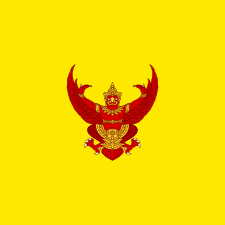 | |
| Reference style | His Majesty |
| Spoken style | Your Majesty |
| Alternative style | Sir |
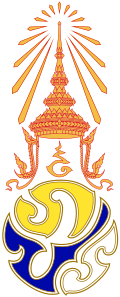
- 5 December 1927 – September 1929: His Highness Prince Bhumibol Adulyadej
- September 1929 – 10 July 1935: His Royal Highness Prince Bhumibol Adulyadej
- 10 July 1935 – 9 June 1946: His Royal Highness Prince Bhumibol Adulyadej, the Prince Brother
- 9 June 1946 – 5 May 1950: His Majesty King Bhumibol Adulyadej (temporary title prior to coronation).
Somdet Phra Chao Yu Hua Bhumibol Adulyadej
(Thai: สมเด็จพระเจ้าอยู่หัวภูมิพลอดุลยเดช) - 5 May 1950 – 13 October 2016: His Majesty The King
- 13 October 2016 - 4 May 2019: His Majesty King Bhumibol Adulyadej
- 5 May 2019 – present: His Majesty King Bhumibol Adulyadej the Great
King Bhumibol Adulyadej's Thai full title was "Phra Bat Somdet Phra Poraminthra Maha Bhumibol Adulyadej Mahitalathibet Ramathibodi Chakkrinaruebodin Sayamminthrathirat Borommanatbophit" (Thai: พระบาทสมเด็จพระปรมินทรมหาภูมิพลอดุลยเดช มหิตลาธิเบศรรามาธิบดี จักรีนฤบดินทร สยามินทราธิราช บรมนาถบพิตร; ![]()
When his son, King Maha Vajiralongkorn ascended the throne on 1 December 2016, King Bhumibol was referred as Phra Bat Somdet Phra Poraminthra Maha Bhumibol Adulyadej Borommanatbophit (Thai: พระบาทสมเด็จพระปรมินทรมหาภูมิพลอดุลยเดช บรมนาถบพิตร)
The literal translation of the title was as follows:[22]
- Phra Bat (Thai: พระบาท) – "Divine Feet", an honorific given to a god or monarch
- Somdet (Thai: สมเด็จ) – "Supremacy", an honorific given to a god or monarch
- Phra (Thai: พระ) – "Divine", an honorific given to a god or monarch
- Poraminthra (Thai: ปรมินทร) – "Highest Indra", an honorific given to an odd-numbered monarch, whilst an even-numbered monarch would use the honorific Poramenthra (Thai: ปรเมนทร)
- Maha (Thai: มหา) – "Great"
- Bhumibol (Thai: ภูมิ พล) – "Strength of the Land"
- Adulyadej (Thai: อดุลยเดช) – "Incomparable Power"
- Mahitalathibet (Thai: มหิตลาธิเบศร) – "Overlord of the Land"
- Ramathibodi (Thai: รามาธิบดี) – "Overlord Rama", a title traditionally occupied by Siamese monarchs
- Chakkrinaruebodin (Thai: จักรี นฤบดินทร) – "Overlord of Mankind from Chakri"
- Sayamminthrathirat (Thai: สยามินทราธิราช) – "Siamese Ruler, the Overlord"
- Borommanatbophit (Thai: บรมนาถบพิตร) – "Supreme Holy Shelter"
On 5 May 2019, Vajiralongkorn bestowed on his father the title Phra Bat Somdet Phra Boromchanakathibet Maha Bhumibol Adulyadej Maharaj Borommanatbophit (Thai: พระบาทสมเด็จพระบรมชนกาธิเบศร มหาภูมิพลอดุลยเดชมหาราช บรมนาถบพิตร). It is extremely rare for a King to be bestowed with a distinction of "Maharaja" (The Great). The last of such was for King Taksin which was posthumously given in 1981, nearly 200 years since the latter's demise. Until 5 May 2019, King Rama I and King Rama V was the only Chakri Dynasty monarchs to be given such distinctions.
Issue
| Name | Birth | Marriage | Children | Grandchildren | |
|---|---|---|---|---|---|
| Date | Spouse | ||||
| Princess Ubolratana Rajakanya | 5 April 1951 | 29 July 1981 Divorced 1998 | Peter Ladd Jensen | Ploypailin Jensen | Maximus Wheeler Leonardo Wheeler Airy Wheeler[181] |
| Poom Jensen | |||||
| Sirikitiya Jensen | |||||
| King Maha Vajiralongkorn | 28 July 1952 | 3 January 1977 Divorced 12 August 1991 | Soamsawali Kitiyakara | Princess Bajrakitiyabha | |
| February 1994 Divorced 1996 | Yuvadhida Polpraserth | Juthavachara Vivacharawongse | |||
| Vacharaesorn Vivacharawongse | |||||
| Chakriwat Vivacharawongse | |||||
| Vatchrawee Vivacharawongse | |||||
| Princess Sirivannavari Nariratana | |||||
| 10 February 2001 Divorced 11 December 2014 | Srirasmi Suwadee | Prince Dipangkorn Rasmijoti | |||
| 1 May 2019 | Suthida | ||||
| Princess Maha Chakri Sirindhorn | 2 April 1955 | Never married | |||
| Princess Chulabhorn Walailak | 4 July 1957 | 1982 Divorced 1996 | Virayudh Tishyasarin | Princess Siribhachudhabhorn | |
| Princess Adityadhornkitikhun | |||||
Ancestors
| Ancestors of Bhumibol Adulyadej | ||||||||||||||||||||||||||||||||||||||||||||||||||||||||||||||||||||||||||||||||||||||||||||||||||||||||||||||||||||||||||||||||||||||||||||||||||||||||||||||||||||||||||||||||||||||||||||||||||||||||||||||||||||||||||||||||||||||||||||||||||||||||||||||||||||||||||||||||||||||||||||||||||||||||||||||||||||||||||||||||||||||||||||||||||||||||||||||||||||||||||||||||||||||||||||||||||||||||||||||||||||||||||||||||||||||||||||||||||||||||||||||||||||||||||||||||||||||||||||||||||||||||||||||||||||||||||||||||||||||||||||||||||||||||||||||||||||||||||||||||||||||||||||||||
|---|---|---|---|---|---|---|---|---|---|---|---|---|---|---|---|---|---|---|---|---|---|---|---|---|---|---|---|---|---|---|---|---|---|---|---|---|---|---|---|---|---|---|---|---|---|---|---|---|---|---|---|---|---|---|---|---|---|---|---|---|---|---|---|---|---|---|---|---|---|---|---|---|---|---|---|---|---|---|---|---|---|---|---|---|---|---|---|---|---|---|---|---|---|---|---|---|---|---|---|---|---|---|---|---|---|---|---|---|---|---|---|---|---|---|---|---|---|---|---|---|---|---|---|---|---|---|---|---|---|---|---|---|---|---|---|---|---|---|---|---|---|---|---|---|---|---|---|---|---|---|---|---|---|---|---|---|---|---|---|---|---|---|---|---|---|---|---|---|---|---|---|---|---|---|---|---|---|---|---|---|---|---|---|---|---|---|---|---|---|---|---|---|---|---|---|---|---|---|---|---|---|---|---|---|---|---|---|---|---|---|---|---|---|---|---|---|---|---|---|---|---|---|---|---|---|---|---|---|---|---|---|---|---|---|---|---|---|---|---|---|---|---|---|---|---|---|---|---|---|---|---|---|---|---|---|---|---|---|---|---|---|---|---|---|---|---|---|---|---|---|---|---|---|---|---|---|---|---|---|---|---|---|---|---|---|---|---|---|---|---|---|---|---|---|---|---|---|---|---|---|---|---|---|---|---|---|---|---|---|---|---|---|---|---|---|---|---|---|---|---|---|---|---|---|---|---|---|---|---|---|---|---|---|---|---|---|---|---|---|---|---|---|---|---|---|---|---|---|---|---|---|---|---|---|---|---|---|---|---|---|---|---|---|---|---|---|---|---|---|---|---|---|---|---|---|---|---|---|---|---|---|---|---|---|---|---|---|---|---|---|---|---|---|---|---|---|---|---|---|---|---|---|---|---|---|---|---|---|---|---|---|---|---|---|---|---|---|---|---|---|---|---|---|---|---|---|---|---|---|---|---|---|---|---|---|---|---|---|---|---|---|---|---|---|---|---|---|---|---|---|---|---|---|---|---|---|---|---|---|---|---|---|---|---|---|---|---|---|---|---|---|---|---|---|---|---|---|---|---|---|---|---|---|---|---|---|---|---|---|---|---|---|---|---|---|---|---|---|---|---|---|---|---|---|---|---|---|---|---|---|---|---|---|---|---|---|---|---|---|---|---|---|---|---|---|---|---|---|---|---|---|---|---|---|---|---|---|---|---|---|---|---|---|---|---|---|---|---|---|---|---|---|---|---|---|---|---|---|---|---|---|---|---|---|---|---|---|---|---|---|---|---|---|---|---|---|
| ||||||||||||||||||||||||||||||||||||||||||||||||||||||||||||||||||||||||||||||||||||||||||||||||||||||||||||||||||||||||||||||||||||||||||||||||||||||||||||||||||||||||||||||||||||||||||||||||||||||||||||||||||||||||||||||||||||||||||||||||||||||||||||||||||||||||||||||||||||||||||||||||||||||||||||||||||||||||||||||||||||||||||||||||||||||||||||||||||||||||||||||||||||||||||||||||||||||||||||||||||||||||||||||||||||||||||||||||||||||||||||||||||||||||||||||||||||||||||||||||||||||||||||||||||||||||||||||||||||||||||||||||||||||||||||||||||||||||||||||||||||||||||||||||
Works
- HM King Bhumibol Adulyadej of Thailand. The Story of Tongdaeng. Amarin Book, Bangkok. 2004. ISBN 974-272-917-4
- HM King Bhumibol Adulyadej of Thailand. The Story of Mahajanaka: Cartoon Edition. Amarin Book, Bangkok. 1999. ISBN 974-272-074-6
- HM King Bhumibol Adulyadej of Thailand. The Story of Mahajanaka. Amarin Book, Bangkok. 1997. ISBN 974-8364-71-2
- HM King Bhumibol Adulyadej of Thailand, Chaturong Pramkaew (Ed.). My Country Thailand...land of Everlasting Smile. Amarin Book, Bangkok. 1995. ISBN 974-8363-53-8
- HM King Bhumibol Adulyadej of Thailand. His Majesty the King's Photographs in the Development of the Country. Photographic Society of Thailand & Thai E, Bangkok. 1992. ISBN 974-88805-0-8
- HM King Bhumibol Adulyadej of Thailand. Paintings by his Majesty the King: Special exhibition for the Rattanakosin Bicentennial Celebration at the National Gallery, Chao Fa Road, Bangkok, 1 April – 30 June 1982. National Gallery, Bangkok. 1982. ASIN B0007CCDMO
See also
| Wikimedia Commons has media related to: |
- Golden Jubilee Diamond, the largest faceted diamond in the world, presented to Bhumibol Adulyadej on the 50th anniversary of his coronation
- Constitution of Thailand, describing the evolution of Bhumibol's constitutional rights and responsibilities
- History of Thailand (1932–1973)
- History of Thailand (1973–2001)
- Public holidays in Thailand
- Thai royal and noble titles
- List of longest-reigning monarchs
- Royal Flags of Thailand
Namesakes
- Bhumibol Adulyadej Hospital
- Bhumibol Dam
- Rama IX Bridge
- Bhumibol Bridge
- Kanchanaphisek ("Golden Jubilee") Bridge
- Kanchanaphisek National Museum
- Phra Ram 9 Road
- Bhumibol Square
- Rama IX royal park
- Suvarnabhumi Airport
References
- Stengs, Irene (1 January 2009). Worshipping the Great Moderniser: King Chulalongkorn, Patron Saint of the Thai Middle Class. NUS Press. ISBN 9789971694296.
- Grossman, Nicholas (1 January 2009). Chronicle of Thailand: Headline News Since 1946. Editions Didier Millet. ISBN 9789814217125.
- Fry, Gerald W.; Nieminen, Gayla S.; Smith, Harold E. (8 August 2013). Historical Dictionary of Thailand. Scarecrow Press. ISBN 9780810875258.
- The Rotarian. Rotary International. 13 October 2016.
- "Thailand's King Bhumibol Adulyadej, world's longest-reigning monarch, dies". The Hindu. Reuters. 13 October 2016. Retrieved 14 October 2016.
- "A Royal Occasion speeches". Journal. Worldhop. 1996. Archived from the original on 12 May 2006. Retrieved 5 July 2006.
- Redmond, Brien (13 October 2016). "Thailand's King Bhumibol Dies, Triggering Anguish and Fears of Unrest". The Daily Beast. Retrieved 14 October 2016.
- Simon Mortland (20 January 2012). "In Thailand, A Rare Peek at His Majesty's Balance Sheet". Forbes. Retrieved 26 January 2014.
- "The British Royal Family Is Worth $88 Billion".
- Serafin, Tatiana (7 July 2010). "The World's Richest Royals". Forbes. Retrieved 17 October 2015.
- "The World's Richest Royals". Forbes. 29 April 2011. Retrieved 26 January 2014.
- Joshua Kurlantzick (24 January 2012). "Forbes Looks into the King of Thailand's Wealth". Council on Foreign Relations. Archived from the original on 3 February 2014. Retrieved 26 January 2014.
- Kohler, Chris (24 April 2014). "The business of royalty: The five richest monarchs in the world". Business Spectator. Business Spectator Pty Ltd. Retrieved 6 May 2014.
- Palling, Bruce (13 October 2016). "King Bhumibol Adulyadej obituary". The Guardian. Retrieved 22 January 2020.
- Head, Jonathan (5 December 2007). "Why Thailand's king is so revered". BBC News. Retrieved 17 October 2015.
- Mullen, Jethro. "Thailand's King Bhumibol leaves hospital for seaside". cnn.com. Retrieved 14 October 2016.
- Holmes, Oliver (13 October 2016). "Thai king Bhumibol Adulyadej dies after 70-year reign". The Guardian. Retrieved 10 September 2017.
- "Thailand's King Bhumibol, world's longest reigning monarch, dies at 88". Reuters. 13 October 2016. Retrieved 10 September 2017.
- Yimprasert, Junya (2010). "Why I don't love the King". Global Labour Institute. Retrieved 10 September 2017.
- "Lese majeste charge against scholar dropped". 18 January 2018.
- "Thai king's cremation set for Oct. 26: government official". Reuters. 19 April 2017. Retrieved 10 September 2017.
- "Biography of His Majesty King Bhumibol Adulyadej". The Golden Jubilee Network. Kanchanapisek Network. Retrieved 17 October 2015.
- Grossman, Nicholas; Faulder, Dominic (2012). King Bhumibol Adulyadej – A Life's Work. Editions Didier Millet. ISBN 978-9814260565.
- Handley, Paul M. (2006). The King Never Smiles. Yale University Press. ISBN 0-300-10682-3.
- For an in-depth exploration of this theory, see MacGregor Marshall, Andrew (2013). "Thailand's saddest secret".
- "King Bhumibol Adulyadej of Thailand – obituary". The Daily Telegraph. 13 October 2016.
- Bhirom Bhakdi, Soravij. "Queens of the Chakri Dynasty". Archived from the original on 14 July 2006. Retrieved 1 August 2006.
- "The Making of a Monarch". Bangkok Post. 5 December 2005. Archived from the original on 15 July 2006. Retrieved 12 July 2006.
- "The Royal Family". Manora Property Hua Hin. Manora Company Limited Hua Hin. Archived from the original on 16 March 2017. Retrieved 15 March 2017.
- "Khun Poom Jensen, Son of Princess Ubolratana". Soravij.com. Archived from the original on 28 December 2007. Retrieved 24 November 2007.
- Lui, Caitlin; Tony Perry (29 December 2004). "Thais Saddened by the Death of Young Prince". Los Angeles Times. Retrieved 23 December 2013.
- "Royal Power Controversy". 2Bangkok.com. Archived from the original on 18 October 2006. Retrieved 4 January 2007.
- "The Royal Regalia and Royal Utensils of Siam". Chiangmai & Chiangrai Magazine. Archived from the original on 6 September 2017. Retrieved 10 September 2017.
- "Thailand Monarchy". Thailand Travel and Tours. 2006. Archived from the original on 8 October 2007. Retrieved 26 September 2007.
- Thak Chaloemtiarana (1979). Thailand: The Politics of Despotic Paternalism. Social Science Association of Thailand. p. 98.
- Rattanasengchanh, Phimmasone M (2012). Thailand's Second Triumvirate: Sarit Thanarat and the Military, King Bhumibol Adulyadej and the Monarchy and the United States, 1957–1963 (Masters thesis). Seattle: University of Washington.
- Mallet, Marian (1978). "Causes and Consequences of the October '76 Coup". Journal of Contemporary Asia. 8 (1). Archived from the original on 6 October 2016. Retrieved 5 October 2016.
- "Royal Birthday Address: 'King Can Do Wrong'". National Media. 5 December 2005. Archived from the original on 30 September 2007. Retrieved 26 September 2007.
- Suwannathat-Pian, Kobkua (1995). Thailand's Durable Premier. Oxford University Press. p. 30. ISBN 967-65-3053-0.
- "The Proclamation Imposing Martial Law throughout the Kingdom". The Government Gazette of Thailand. 74 (76). 16 September 1957.
- "The Proclamation Appointing the Military Defender" (PDF). The Government Gazette of Thailand. 74 (76). 16 September 1957.
- Translated from Matichon Weekly. 20–26 July 2018 p.55.
- Evans, Dr. Grant; citing Christine Gray (1998). "The Politics of Ritual and Remembrance: Laos since 1975". Laosnet.org. Retrieved 5 July 2006.
- Evans, Dr. Grant (1998). The Politics of Ritual and Remembrance: Laos since 1975. University of Hawaii Press. pp. 89–113. ISBN 0-8248-2054-1.
- Klinkajorn, Karin. "Creativity and Settings of Monuments and Sites in Thailand: Conflicts and Resolution" (PDF). International Council on Monuments and Sites. Archived (PDF) from the original on 23 July 2006. Retrieved 5 July 2006.
- ประกาศสำนักนายกรัฐมนตรี เรื่อง ให้ถือวันพระราชสมภพ เป็นวันเฉลิมฉลองของชาติไทย, ราชกิจจานุเบกษา เล่ม 77 ตอน 43 24 พฤษภาคม 2503 หน้า 1452
- Thongthong Chandrangsu, A Constitutional Legal Aspect of the King's Prerogatives (M.A. thesis) Chulalongkorn University, 1986, page 160
- ใจ อึ๊งภากรณ์, บทความ รศ.ใจ อึ๊งภากรณ์ วิจารณ์: The King Never Smiles Archived 11 March 2007 at the Wayback Machine, 14 ธันวาคม 2549
- ทักษ์ เฉลิมเตียรณ, การเมืองระบบพ่อขุนอุปถัมภ์แบบเผด็จการ, สำนักพิมพ์มหาวิทยาลัยธรรมศาสตร์ 2525
- Rosario, Prizzia (1985). Thailand in transition: the role of oppositional forces. University of Hawaii Press.
- Stevenson, William (2001). The Revolutionary King. Constable and Robinson. P. 180-183
- "His Gracious Majesty". The Nation. 2 February 2007. Archived from the original on 13 October 2007. Retrieved 25 September 2007.
- Michael Schmicker, Asian Wall Street Journal, 23 December 1982
- สุลักษณ์ ศิวรักษ์, "ลอกคราบสังคมไทย", กรุงเทพฯ: หนังสือไทย, 2528
- Anonymous, "The Chakri Dynasty and Thai Politics, 1782–1982", cited in Handley
- https://www.nytimes.com/1989/05/21/magazine/king-bhumibol-s-reign.html
- "Development Without Harmony". Southeast Asian Ministers of Education Organization. 2000. Archived from the original on 27 September 2007. Retrieved 26 September 2007.
- "Biography of Chamlong Srimuang". The 1992 Ramon Magsaysay Award for Government Service. Ramon Magsaysay Award Foundation. 2000. Archived from the original on 14 October 2007. Retrieved 26 September 2007.
- The Royal Jubilee Network, พระราชดำรัส พระราชทานแก่คณะบุคคลต่างๆ ที่เข้าเฝ้าฯ ถวายชัยมงคล ในโอกาสวันเฉลิมพระชนมพรรษา ณ ศาลาดุสิดาลัย สวนจิตรลดา พระราชวังดุสิตฯ วันพุธที่ ๔ ธันวาคม พ.ศ. ๒๕๔๕ (ฉบับไม่เป็นทางการ)
- Michael K. Connors, Ambivalent About Rights: "Accidental" Killing Machines, Democracy and Coups d'Etat., Draft paper presented to Human Rights in Asia Workshop, University of Melbourne, 1–2 October 2009.
- Anucha Yuwadee, Bangkok Post, 15 January 2003
- National News Bureau of Thailand, Academics call for law to prosecute Thaksin in World Court, 28 June 2010
- "A Wave of Drug Killings Is Linked to Thai Police" By Seth Mydans, 8 April 2003 New York Times
- Amnesty International report: Thailand: Grave developments – Killings and other abuses
- "Drug-Related Killings: Verify the toll, say diplomats". The Nation. 4 March 2003. Archived from the original on 30 June 2015.
- Thailand: Public Senses War On Drugs Futile 20 March 2005
- "พระราชดำรัส พระราชทานแก่คณะบุคคลต่างๆ ที่เข้าเฝ้าฯ ถวายชัยมงคล ในโอกาสวันเฉลิมพระชนมพรรษา ณ ศาลาดุสิดาลัย สวนจิตรลดา พระราชวังดุสิตฯ วันพฤหัสบดีที่ ๔ ธันวาคม พ.ศ. ๒๕๔๖ (ฉบับไม่เป็นทางการ)". The Golden Jubilee Network. 2003. Archived from the original on 15 October 2011.
- Asia Sentinel The Long Wait for Justice in Thailand, 10 August 2007
- "Kanit to chair extrajudicial killings probe" Bangkok Post, 3 August 2007 Archived 6 October 2007 at the Wayback Machine
- "Thailand's drug wars. Back on the offensive" 24 January 2008 The Economist
- Thailand Times, Thaksin's 'Drug Murders' investigated Archived 2 April 2012 at the Wayback Machine, 10 June 2010
- "HM the King's 26 April speeches". The Nation. Archived from the original on 8 July 2006. Retrieved 5 July 2006.
- "Constitution Court invalidate the April election and order new election". The Nation. Archived from the original on 16 June 2006. Retrieved 5 July 2006.
- "EC Commissioners arrive at Bangkok Remand Prison". The Nation. Archived from the original on 5 August 2006. Retrieved 25 July 2006.
- "EC Guilty in Historic Ruling". Bangkok Post. Archived from the original on 10 October 2007. Retrieved 25 July 2006.
- Tinsulanonda, General Prem (14 July 2006). "A special lecture to CRMA cadets". Chulachomklao Royal Military Academy. Archived from the original on 7 November 2007. Retrieved 25 September 2007.
- Kosajan, Worranaree (22 July 2006). "King urges fair poll". The Nation. Archived from the original on 14 March 2007. Retrieved 5 April 2007.
- "Thai Military Launches Coup to Remove PM Thaksin". Fox News. Associated Press. 19 September 2006. Archived from the original on 20 September 2006. Retrieved 19 September 2006.
- "Coup as it unfolds". The Nation. 20 September 2006. Archived from the original on 29 September 2007. Retrieved 25 September 2007.
- McGeown, Kate (21 September 2006). "Thai king remains centre stage". BBC News. Archived from the original on 9 September 2007. Retrieved 25 September 2007.
- "Thai junta vows action against foreign media". ABC News. 23 September 2006. Archived from the original on 13 October 2007. Retrieved 25 September 2007.
- "Thailand's post-coup cabinet unveiled". The Australian. 9 October 2006. Archived from the original on 12 March 2007. Retrieved 16 October 2006.
- "NLA 'doesn't represent' all of the people". The Nation. 14 October 2006. Archived from the original on 2 November 2006. Retrieved 16 October 2006.
- "Assembly will not play a major role". The Nation. 14 October 2006. Archived from the original on 16 January 2007. Retrieved 16 October 2006.
- The Malaysian Insider, Feared Thai ex-general warns of bloodshed Archived 25 January 2016 at the Wayback Machine, 1 September 2008
- Financial Times, Thaksin claims Thailand's king knew of coup plot, also available at this and this page, 20 April 2009
- Ahuja, Ambika (25 May 2007). "Thai king urges firm, clear verdict in key case". China Post. Taiwan (ROC). Archived from the original on 30 September 2007. Retrieved 25 September 2007.
- "Thai king against dissolving parties". Gulf Times. 25 May 2007. Archived from the original on 30 September 2007. Retrieved 25 September 2007.
- "Thai king warns over court ruling". BBC News. 25 May 2007. Archived from the original on 7 October 2007. Retrieved 25 September 2007.
- Schuettler, Darren (13 August 2007). "Academic accused of insulting Thai king in exam paper". Reuters. Archived from the original on 10 January 2008. Retrieved 24 November 2007.
- "สำนักราชเลขาธิการ" (PDF). ohmpps.go.th. Archived from the original (PDF) on 24 March 2012. Retrieved 14 October 2016.
- The Economist, Fuelling the pyre, 16 October 2008
- ABC News, Thai power base useless in bridging social divide, 28 November 2008
- International Herald Tribune, Thai protesters gird for a crackdown, 28 November 2008
- Reuters, Q+A-Thailand's intractable political crisis, 27 November 2008
- Asia Times, More turmoil in beleaguered Bangkok, 25 November 2008
- Reuters, Welcome to Bangkok airport – no passport needed, 29 November 2008
- The Australian, Embarrassed citizens plan retaliation Archived 3 December 2008 at the Wayback Machine, 1 December 2008
- MSNBC, Thailand's Political Maze—A Beginners Guide, 26 November 2008
- The Economist, A right royal mess, 4 December 2008
- "Former Air Force chief Chalit appointed privy councillor". The Nation. 19 May 2011. Archived from the original on 22 May 2011.
- "Doctors to Perform Surgery on Thai king, 78". Bangkok Post. Archived from the original on 10 October 2007. Retrieved 20 July 2006.
- "Doctors to perform surgery to cure lumbar spine stenosis for His Majesty". The Nation. Archived from the original on 29 September 2007. Retrieved 20 July 2006.
- "Thailand's king taken to hospital". BBC News. 28 May 2014. Retrieved 24 November 2007.
- "Thai King sparks pink shirt craze". BBC News. 28 May 2014. Retrieved 30 November 2007.
- WikiLeaks cables reveal scandal and disease in Thai royal family The Australian, 24 June 2011
- "Household Bureau: The King incurs diverticulitis". Manager Online. Retrieved 20 November 2011.
- "Thai king suffers brain bleeding". 13 July 2012.
- "Thailand peaceful for king's birthday". The Guardian. 28 May 2014. Retrieved 5 December 2013.
- "Thailand's King Bhumibol Adulyadej leaves hospital". BBC News. 2 August 2013.
- "Thailand's ailing King Bhumibol Adulyadej returns to hospital". Sydney Morning Herald. 1 June 2015.
- "Thailand celebrates long-reigning, but ailing King Bhumibol's 88th birthday". Straits Times. 5 December 2015.
- "Thailand's King Bhumibol Adulyadej makes rare appearance". BBC News. 22 December 2015.
- "Well-wishers flock to Siriraj as King leaves for palace visit". Bangkok Post. Reuters.
- Matt Thomas, Fears over Thai king's health continue to grow. International Business Times, 1 October 2016.
- Ailing Thai king's lung infection eases, kidneys still failing: Palace Archived 13 October 2016 at the Wayback Machine. Channel News Asia, 2 October 2016.
- Juliana Pignataro, What Is Hemodialysis? Thailand King Bhumibol May Be Dying As Health Condition Worsens. International Business times, 10 October 2016.
- Ailing Thai king's health 'not stable' says palace. Yahoo News, 9 October 2016.
- Amy Sawitta Lefevre and Panarat Thepgumpanat, Thais wear auspicious pink to help hospitalized king recover. Reuters, via Yahoo News, 10 October 2016.
- Philip Sherwell, Thailand's longtime king, a figure of unity and stability, gravely ill. Washington Post, 12 October 2016.
- Richard C. Paddock, Worries Over King Bhumibol Adulyadej’s Health Shake Thailand. New York Times, 12 October 2016.
- Camila Domonoske, Thai King's Health 'Not Stable,' Palace Says, Reigniting Succession Fears. NPR, 10 October 2016.
- Twilight of the king – After the ailing monarch goes, what next? The Economist, 23 July 2016.
- "'Anchœ̄n phrabǭrommasop phrabātsomdet phračhāoyūhūa nai phrabǭrommakōt khlư̄an khabūan siphā nālikā" อัญเชิญพระบรมศพพระบาทสมเด็จพระเจ้าอยู่หัวในพระบรมโกศ เคลื่อนขบวน 15.00 น. [Late king's body to be moved in procession at 15:00 hrs]. Thai Rath. Bangkok: Wacharaphon. 14 October 2016. Retrieved 14 October 2016.
- "Rituals in a Royal's death". The Nation. Retrieved 15 March 2017.
- "Thailand's King Bhumibol Adulyadej, world's longest-reigning monarch, dies". Reuters. 13 October 2016 – via The Hindu.
- "Thailand's King Bhumibol Adulyadej dead at 88". BBC News. 13 October 2016.
- "Thai Royal Burial Sites".
- "Coronation of HM King Maha Vajiralongkorn to be held 4–6 May: palace". The Nation. Retrieved 1 January 2019.
- "My govt serves His Majesty". The Nation. 9 September 2005. Retrieved 14 August 2006.
- "Senate steers clear of motion on Jaruvan". The Nation. 11 October 2005. Archived from the original on 28 August 2006. Retrieved 14 August 2006.
- "Aussie pedophile free on royal pardon". The Nation. 2006. Archived from the original on 7 July 2006. Retrieved 5 July 2006.
- McDonald, Phillipa (30 June 2006). "Campaigners condemn paedophile's release". ABC News Online. Archived from the original on 2 July 2006. Retrieved 5 July 2006.
- Bathersby, Damien (2 July 2006). "Royal pardon for child predator". Sunshine Coast Daily. Retrieved 5 July 2006.
- Duncan McCargo, Network monarchy and legitimacy crises in Thailand, The Pacific Review, Volume 18, Issue 4 December 2005
- Federico Ferrara, Thailand Unhinged: unraveling the myth of a Thai-style democracy, Equinox Publishing 2010
- DW.de, Thai monarchy a hindrance to democracy?, 28 January 2013
- "The Burning of the Thai Embassy in Cambodia". The Nation, 2Bangkok.com. 2003. Archived from the original on 26 June 2006. Retrieved 5 July 2006.
- "Sufficiency Economy: Implications and Applications" (PDF). NESDB. Archived from the original (PDF) on 19 July 2011. Retrieved 6 May 2010.
- Chitbundid, Chanida (2003). "The Royally-initiated Projects: The Making of Royal Hegemony (B.E. 2494–2546)". Thammasat University. Archived from the original on 30 June 2015. Retrieved 27 June 2015.
- "In the part of Royal Irrigation Department's Responsibilities". Archived from the original on 31 December 2008.
- "ทฤษฎี "แกล้งดิน" อันเนื่องมาจากพระราชดำริ".
- "The Projects". Office of the Royal Development Projects Board. Archived from the original on 3 November 2007. Retrieved 26 July 2009.
- "World Soil Day 5 December". United Nations. Retrieved 8 December 2019.
- "Thailand and UN's FAO collaborate to stop soil erosion to ensure future food security" (Press release). Relief Web. Food and Agriculture Organization of the United Nations. 7 December 2019. Retrieved 8 December 2019.
- Pinyorat, Rungrawee C. (2006). "Millions of Thai honor king". Boston.com News. Associated Press. Archived from the original on 13 October 2007. Retrieved 5 July 2006.
- "Govt launches commemorative events for HM the King's 80th birthday". The Nation. 16 February 2007. Archived from the original on 13 October 2007. Retrieved 25 September 2007.
- HM King Bhumibol Adulyadej of Thailand. The Story of Tongdaeng. Amarin, Bangkok. 2004. ISBN 974-272-917-4
- MCOT, Commerce Ministry launches film to honour creative King Bhumibol, 10 February 2010
- Tang, Alisa (13 June 2006). "Thailand's monarch is ruler, jazz musician". Washington Post. Associated Press. Retrieved 27 May 2014.
- "King Bhumibol Adulyajej and Music". King Bhumibol Adulyajej A Musical Self-Portrait. Archived from the original on 4 March 2016. Retrieved 15 March 2017.
- "The Jazzy King". Bangkok Post. 10 January 2006. Retrieved 27 May 2014.
- Bhumibol Adulyadej (King of Thailand) Collection, 1946-1954 at Library of Congress
- "The Heart for Art". Bangkok Post. 6 February 2006. Archived from the original on 26 October 2006. Retrieved 20 July 2006.
- Cummins, Peter (December 2004). "His Majesty King Bhumibol Adulyadej The Great: Monarch of Peace and Unity". Chiang Mai Mail. Retrieved 20 July 2006.
- "Archived copy". Archived from the original on 18 October 2016. Retrieved 14 October 2016.CS1 maint: archived copy as title (link)
- "H.M. King Bhumibol Adulyadej". Ministry of Foreign Affairs, Kingdom of Thailand. Archived from the original on 15 January 2016. Retrieved 4 March 2008.
- "Official web site of the Radio Amateur Society of Thailand under the Royal Patronage of His Majesty the King".
- "Long Live The King!". Bangkokker. 9 June 2006. Retrieved 17 August 2006.
- "H.M. Biography". Assumption University. 9 June 2006. Archived from the original on 15 July 2006. Retrieved 17 August 2006.
- "Thai king's patent to make rain". BBC News. 27 March 2003. Archived from the original on 26 June 2006. Retrieved 14 August 2006.
- "Weather Modification by Royal Rainmaking Technology". 60th Celebrations. 17 June 2006. Archived from the original on 19 October 2006. Retrieved 14 August 2006.
- "Thai King gets rainmaking patent". 60th Celebrations. 9 June 2006. Archived from the original on 30 June 2006. Retrieved 14 August 2006.
- Horn, Robert (6 December 1999). "The Banker Who Saved A King". Time Asia. Retrieved 5 July 2006.
- Horn, Robert (20 August 2008). "Forbes The world's richest royals". Forbes. Retrieved 21 August 2008.
- "Forbes Says Bhumipol Richest Person in World" (in Thai). ASTV. 23 August 2008. Retrieved 17 October 2015.
- Pendelton, Devon; Serafin, Tatiana (30 August 2007). "The World's Richest Royals". Forbes. Archived from the original on 3 March 2008. Retrieved 4 March 2008.
- "Thailand's Royal Wealth: How Thailand's Royals Manage to Own All the Good Stuff". Asia Sentinel. 1 March 2007. Archived from the original on 27 September 2007. Retrieved 25 September 2007.
- "King Bhumibol as world's wealthiest royal: Forbes". Manager Online. New York. AFP. 22 August 2008. Retrieved 13 October 2016.
- "Royal Assets Structuring Act of 1936". The Crown Property Bureau (in Thai). 2007. Archived from the original on 9 August 2007. Retrieved 25 September 2007. (พระราชบัญญัติ จัดระเบียบทรัพย์สิน ฝ่ายพระมหากษัตริย์)
- Champion, Paul (25 September 2007). "Professor in lese majeste row". Reuters. Archived from the original on 13 October 2007. Retrieved 26 September 2007.
- "High time to concede the Thai king can do wrong". Financial Times. 20 July 2011. Retrieved 22 February 2018.
- Warrick-Alexander, James (6 February 2006). "Thailand Bars Univ. Website". Yale Daily News. Retrieved 5 July 2006.
- Stevenson, William (2001). The Revolutionary King. Constable and Robinson. ISBN 1-84119-451-4.
- McCarthy, Terry (6 December 1999). "The King and Ire". Time Asia. Retrieved 5 July 2006.
- The Royal Gazette, 28 December 1972
- "Biography of Her Royal Highness Princess Maha Chakri Sirindhorn". The Golden Jubilee Network. 2004. Archived from the original on 2 July 2006. Retrieved 5 July 2006.
- Aryan, Gothan (16 September 2004). "Thai Monarchy" (PDF). International Institute for Democracy and Electoral Assistance. Archived from the original (PDF) on 23 June 2006. Retrieved 5 July 2006. presented in Kathmandu, Nepal
- http://www.ratchakitcha.soc.go.th/DATA/PDF/2493/D/014/1001.PDF
- http://www.ratchakitcha.soc.go.th/DATA/PDF/2493/D/014/994.PDF
- "คุณพลอยไพลิน เจนเซน อุ้มธิดาน้อย ร่วมชมงาน อุ่นไอรักคลายความหนาวฯ". Khao Sod (in Thai). 14 January 2019.
Further reading
Biographies
- Richard Broderick (2013). King by Virtue: Reflections of the Lifelong Endeavor of King Bhumipol of Thailand (2nd ed.). Bangkok: Thai Khadi Research Institute. ISBN 978-974-466-717-5.
- Nicholas Grossman; Dominic Faulder, eds. (2011). King Bhumibol Adulyadej – A Life's Work: Thailand's Monarchy in Perspective. Singapore: Editions Didier Millet. ISBN 978-981-4260-56-5.
- (Review by Michael J. Montesano, Contemporary Southeast Asia, Vol. 34/1 (Apr 2012), pp. 128–132)
- Paul M. Handley (2006). The King Never Smiles: A Biography of Thailand's Bhumibol Adulyadej. New Haven, Conn.: Yale University Press. ISBN 978-0-300-10682-4.
- (Review by Kevin Hewison, Journal of Historical Biography, Vol. 4 (Autumn 2008), pp. 115–122)
- (Review by Paul W. Chambers, Contemporary Southeast Asia, Vol. 29/3 (Dec 2007), pp. 529–532)
- Death of King Bhumibol Adulyadej evokes recall of memorable 700 year old Sri Lanka – Thai ties
Bhumibol Adulyadej House of Chakri Born: 5 December 1927 Died: 13 October 2016 | ||
| Regnal titles | ||
|---|---|---|
| Preceded by Ananda Mahidol |
King of Thailand 1946–2016 |
Succeeded by Maha Vajiralongkorn |
